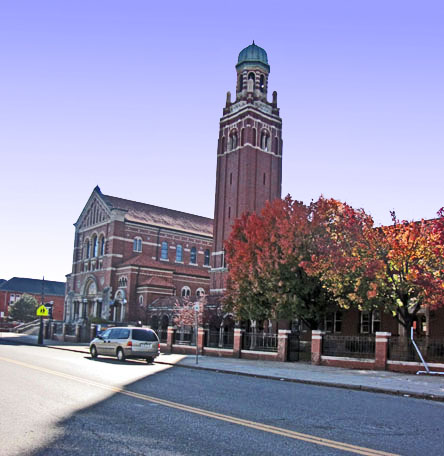
Holy Redeemer Catholic Church
1721 Junction at the corner of West Vernor in southwest Detroit
In the late Nineteenth Century, men in Detroit
and other cities used a great quantity of cigars and chewing tobacco. Women
consumed snuff. Cigarettes were not readily available since J. B. Duke
had
not invented the rolling machine that helped make smoking very popular. In
most large cities, there once were dozens of firms importing tobacco
and than using it to
hand rolling cigars or cut it for plug tobacco. Daniel Scotten, an early Irish immigrant to the city,
became the first of his ethnicity to rise to the top economic ranks,
thanks
to his successful development of tobacco manufacturing. By 1900, Detroit
ranked among the top 6 cities in the US in tobacco production. In the late Nineteenth Century, southwestern Ontario supplied Detroit manufactgurers with their tobacco. Later, the produced imported much Cuban tobacco for their cigars and cut plug.
in tobacco production. In the late Nineteenth Century, southwestern Ontario supplied Detroit manufactgurers with their tobacco. Later, the produced imported much Cuban tobacco for their cigars and cut plug.
One of Daniel Scotten's larger plants was located on West Fort near the intersection of Clark. Irish immigrants continued to come to Detroit in large numbers late in the Nineteenth Century, and a considerable number of them found employment in Scotten's cigar factories. Indeed, this was one industry that employed many women, primarily to roll cigars. The Redemptorist fathers founded Holy Redeemer Parish on Junction in 1880 and soon served the needs of very large numbers of Irish immigrants. Rapidly, they build a huge religious complex—a church that accomodated almost 1,000—reminding us of both the willingness of immigrants to support their church and the efforts of the priests to provide a complete community to their parishoners. Note the large schools, the recreation halls, and the massive convent and rectory that were built adjacent to the huge church. Almost all of this construction was completed just after World War I. Until the suburbanization of whites, the parish continued to grow and Holy Redeemer was, just after World War II, the largest Catholic parish in the United States. The 14 Sunday Masses were, apparently, attended by more than 15,000 of the faithful.
Father Aegidius Smulders founded this parish. He was a missionary who came to the United States. He served as a Catholic chaplin in the Confederate Army, but lost that job when Robert E. Lee surrendured to Ulysses S. Grant. Father Smulders was unemployed at the age of 65, He came to Detroit where there were other Redemptorist priest and created what eventually became the nation's largest Catholic parish. This area of Junction was sandy soil when the frame church was built in 1880. The present church was designed in 1920 in a basilica style resembling the Church of St. Paul in Rome. The extremely impressive and large stone campanile that dominates the neighborhoods was built between 1924 and 1927 in memory of the young men from the parish who died in World War I.
This parish also illustrate an important type of recycling occurring in many religious facilities throughout urban American. The Irish and their descendents moved to the suburbs after World War II, but the surrounding neighborhood is once again an immigrant neighborhood and the church now serves the needs of the many immigrants arriving from Mexico.
Architect: John Donaldson and Henry Meier
Stained Glass Windows: Charles J. Connick
Date of Construction: 1921
Use in 2014: Roman Catholic parish church
Website for the parish: http://www.holyredeemer.comcastbiz.net/
City of Detroit Designated Historic Districts:
Michigan Registry of Historic Sites:
National Register of Historic Places: This church is within the West Vernor-Junction Historic District listed December, 2002.
Photograph: Ren Farley
Description Updated: June, 2014